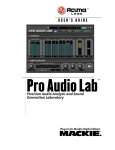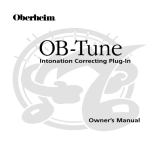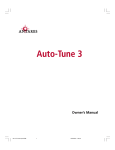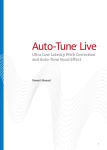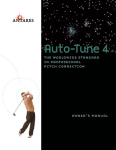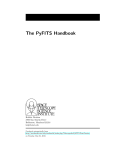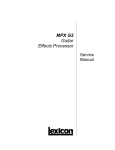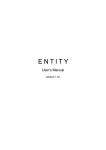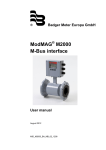Download Antares ATR-1 User`s guide
Transcript
USER’S GUIDE Auto-Tune ™ Antares Advanced Tuning Effects Plug-in for Mackie Digital Mixers ® ™ Iconography This icon identifies a description of how to perform an action with the mouse. This icon identifies a description of how to perform an action from the console. This icon will lead you to some further explanations of features and practical tips. This icon marks information which is very important, so please make sure you have a read. “Mackie” and the “Running Man” figure are trademarks or registered trademarks of Mackie Designs Inc. All other brand names mentioned are trademarks or registered trademarks of their respective holders, and are hereby acknowledged. Part No. 820-252-00 Rev. A 03/2001 © 2001 Mackie Designs Inc. All Rights Reserved. 2 Antares Auto-Tune Contents Introduction ----------------------------------------4 About Antares ---------------------------------------------------4 About the D8B UFX Card -------------------------------------- 5 About Auto-Tune------------------------------------------------ 5 Let’s Get Started ---------------------------------- 6 Requirements ----------------------------------------------------6 Authorizing the Plug-in ----------------------------------------6 Unlock Procedure ----------------------------------------------- 7 Configuring the Plug-in --------------------------------------- 8 Using the Auto-Tune Plug-in ------------------ 10 Front Panel Overview ---------------------------------------- 10 Global Controls ------------------------------------------------ 11 Auto-Tune Controls ------------------------------------------- 13 Vibrato Controls ---------------------------------------------- 18 Saving, Loading, and Resetting a Preset ----------------- 19 Automation and Snapshot Control ---------- 22 FX Routing ---------------------------------------- 23 More about Scales------------------------------- 28 Note: Any future revisions of this guide will be available for viewing and downloading from our website: www.mackie.com. User’s Guide 3 Introduction Thank you for purchasing Auto-Tune from Antares. It is one of the exciting new family of 24-bit plug-ins for the D8B, specifically designed for the new Mackie Universal Effects (UFX) card. The Auto-Tune plug-in is a precision instrument for controlling pitch, allowing you to apply nuances of intonation to virtually any performance. This plug-in is an implementation of the Antares Auto-Tune pitch correcting software for the Mac and PC. It employs state-of-the-art digital signal processing algorithms to continuously detect the pitch of a periodic input signal (typically a solo voice or instrument) and instantly and seamlessly change it to a desired pitch (defined by a number of user-programmable scales). About Antares Antares Audio Technologies is renowned as a developer of innovative, DSP-based audio software and hardware, including the ATR-1 Intonation Processor, MDT (Multi-band Dynamics Tool) and JVP (Antares Voice Processor) DSP plug-ins. 4 Antares Auto-Tune About the D8B UFX Card The UFX card provides robust processing power for computationheavy plug-ins. The UFX card is a 4-in/4-out architecture, which means it can support four mono, two mono and one stereo, or two stereo sends simultaneously. Up to four UFX cards can be installed in the D8B, allowing up to sixteen simultaneous singlechannel effects, eight stereo plug-ins, or combinations thereof. Note: Earlier D8Bs were fitted with 16 MB of memory. It is recommended that you increase this to 32 MB (as fitted in newer D8Bs) if you install more than one UFX card. Memory upgrade instructions are supplied with each UFX card. About Auto-Tune Auto-Tune is very easy to use. Simply identify a key and scale and the affected signal will automatically conform to that scale in real time, while preserving all of the expressive nuance of the original. Auto-Tune can work while the track is being recorded (instead of as a separate post-recording process). In other words, the tracked vocal goes to tape (or disk) already in tune. Of course, you can always process a track that has already been recorded. Micro-adjustments can be automated using hands-on D8B controls instead of a mouse, a huge advantage when correcting melodies that have modulated to other keys or modes. Up to 4 channels of Auto-Tune can be engaged per UFX card. With 4 UFX cards installed, that’s up to 16 channels of pitch correction! User’s Guide 5 Let’s Get Started Requirements • One or more Mackie UFX cards • Mackie Real Time OS 3.0 Software • Plug-in Software We will assume you have successfully installed a Mackie UFX card and Mackie Real Time OS 3.0 software upgrade. If you have encountered problems with the installation of hardware or software please see their associated user guides or contact Mackie support (www.mackie.com). Authorizing the Plug-in If you have D8B v 3.0 b186 or greater, the plug-in is already installed on the D8B hard drive, however an authorized unlock code must be entered to unlock the plug-in for normal operation. An Unlocked Plug-in AUTHORIZE 1234-5167-89D1 LICENSING D8B Electronic Serial Number (ESN) 6 Antares Auto-Tune D8B SETUP screen’s LICENSING window Unlock Procedure 1. Locate your D8B’s Electronic Serial Number (ESN). This is displayed at the bottom of the Licensing window, which is accessed from the Setup screen. The 12 digit ESN is made from numbers 0–9 and letters A–F. It is unique to the D8B processor, and is not the serial number label on the rear of the control surface or CPU chassis. 2. You will also need your plug-in’s serial number which is printed on the floppy disk label. 3. To obtain the unlock code, have the ESN and plug-in serial number ready. Then you have two options: • Log on to the Mackie plug-in authorization web page: (http://www.mackie.com/d8bauthorize.htm) or • Telephone Mackie Tech Support at 800-258-6883. 4. When you have obtained an unlock code, open the D8B Setup window, and click Licensing. 5. With your plug-in highlighted in the Licensing window, click Authorize, and enter your unlock code in the UNLOCK CODE box. Click Enter, and enjoy your newly expanded console. User’s Guide 7 Configuring the Plug-in After booting the D8B you must assign the Auto-Tune plug-in to a UFX card. See FX Routing on page 23 for more details. Assign the Auto-Tune Plug-in to a UFX card 1. Click the Plugins menu and select Plugins, (or Ctrl+P on the keyboard). 2. In the Plugin Configuration window, locate the card slot that contains the UFX card you wish to assign to. 3. In the Mode column, click the Mono/Stereo toggle button and set it to Mono. 4. In the Plugin column, select Antares Autotune from the drop-down menu. Note: A plug-in can also be loaded from the Setup section on the console. 8 Antares Auto-Tune Assign an Input Source to the Plug-in • Click the plug-in’s INPUT button to select an input source. In the example below, we have chosen the Aux 5 Bus as the input to the plug-in installed in slot 5. When a plug-in is fed from an aux bus, its output appears on the FX Return channels (faders in the EFFECTS bank). The return channel is determined by the slot number and whether the effect output is mono or stereo. For example, a reverb with a mono input and stereo output that is installed in Slot 5 has its outputs on FX 5 and FX 6. Note: The default state for all FX channels is MUTE. You won’t hear the effect until you unmute its FX return channel(s). A plug-in can also receive its input from a channel pre- or postDSP insert or the main stereo left and right bus. When a plug-in is inserted “in line” in this manner, its output is routed directly back into the channel. See FX Routing on page 23 for more details. Removing the Plug-in 1. In the Plugin column, select none from the drop-down menu. 2. Click OK in the Alert dialog box. Note: A plug-in can also be deleted from the Setup section on the console. User’s Guide 9 Using the Auto-Tune Plug-in Front Panel Overview You can think of Auto-Tune as being broken into three sections. 1. Global Controls 2. Auto-Tune Controls 3. Vibrato Controls Global Controls Auto-Tune Controls 10 Antares Auto-Tune Vibrato Controls Global Controls Input Select Display & Drop-down Menu Preset Display/ Select Hide Plug-In Window Button Meter Displays (In/Out) Preset Select Memory A/B Buttons Menu Bypass Button Button Input Select Assign Auto-Tune’s input from any of the DB8’s pre, post, or auxiliary channels. Input and Output Meters The input meter represents the incoming signal from the D8B, with a range from –50 dB to 0 dB. The output meter is located just beneath the input meter. Menu Button The drop-down menu button will enable familiar functions such as undo, redo, load, save, reset, cut, copy and paste. See page 19 for more details. Hide Button The small button located at the top right of the GUI will hide the Auto-Tune window. Preset Selection and Display Toggle the up/down arrows to select from an array of factory presets or your own saved user presets. Note: The Input Source can be set from either the plug-in GUI or the plug-in configuration Window. User’s Guide 11 Memory A/B Memory A and Memory B are two separate storage banks that let you temporarily store setups. This is handy for quickly referencing and comparing sounds while you are creating edits. Bypass This allows the input signal to pass through Auto-Tune without being processed. Click the button again to resume processing. Switching the Bypass state will not cause any audio artifacts, so it can be used in real time for live performance, recording or mixing applications. 12 Antares Auto-Tune Auto-Tune Controls This section is a reference for all of the Auto-Tune controls and describes the function of each control. Scale Display & Drop-down Menu Scale Editor Button Pitch Controller Change Meter Key Display & Dropdown Menu MIDI Input Channel Display Scale Detune Display & Slider Retune Display & Slider Tracking Display & Slider Scale Selection Select the desired scale from the drop-down scale list. The first three scales are equal tempered. These are the ubiquitous scales typically found in Western tonal music. The other scales are historical, ethnic, and microtonal scales. An in-depth discussion of these scales and their history is beyond the scope of this guide. The interested reader will find more information in Tuning In – Microtonality In Electronic Music by Scott R. Wilkinson, published by Hal Leonard Books. For a brief synopsis of scales, see More About Scales on page 28 of this guide. User’s Guide 13 Scale Editor Click the Scale button to open the Scale Editor window. Edits made using this dialog are associated with each scale. That is, each scale retains its own edits separate from the other scales. When finished editing, click the Done button to close the window. Scale Display Key Display Go to Previous Page Go to Next Page Set to Major Scale Set to Minor Scale Cancel Button (to close without saving) Done Button (to close and save) Do Not Track Column Remove Column Note Value Column Cent Value Column The Edit Scale window displays each note of the currently selected scale in the currently selected key. If the selected scale includes more than twelve notes, use the Page Up/Down buttons to scroll through all of the available notes. Beside each note name are two check boxes: Do Not Track and Remove. If neither of these boxes are selected, Auto-Tune treats this note as a normal scale note, i.e., when the input pitch is close to this note, Auto-Tune will correct the pitch to this note at the rate set by the Retune Speed control. 14 Antares Auto-Tune If the Do Not Track box is selected, when the input pitch is close to this note the input will be passed through with no correction. If the Remove box is selected, then the note is simply removed from the current scale. For example, selecting the Chromatic scale and then setting C#, D#, F#, G#, A# to Remove would cause a C Major scale to remain. In that case Auto-Tune would always retune the input to the closest note of the C Major scale. Why Remove? A pitch error greater than 49 cents could allow Auto-Tune to choose notes in a given scale that otherwise would not be played as the incorrect pitch moves through the scale. The scale and key selected by the user might be appropriate but if the pitch error is too great, an undesirable note from the scale could be played. In this instance select the Remove box associated with the culprit note. Key Selection To select the desired key, click the Key button and then click the desired note from the dropdown list. This determines the pitch of the first tone of the scale according to the standard A3 = 440 Hz. User’s Guide 15 Pitch Controller The Pitch Controller is used to force the input to an exact pitch. Trigger the desired note(s) by selecting keys on the keyboard image or by using a MIDI input controller. MIDI Chan 6 As long as a key is selected or held/triggered from an external controller, the chosen note will adjust the input pitch. Only when you release the note will the input return to its original pitch. An external MIDI controller can also be used to gain immediate access to multiple octaves. Note: If you are using a MIDI tempo map or tracking with timecode you can easily program (record) a note value into a MIDI sequencer at a precise location. In this way it is possible to correct a particular problem where the performance might otherwise be fine - using as little processing as possible. Scale Detune The Detune parameter allows you to change the pitch standard of Auto-Tune from the default A = 440Hz. The values are cents (100 cents = 1 semitone or half step). The range of adjustment is from –10 to +10 (10 being 100 cents). The Detune function can be used to tune a vocal performance to some irreparably out-of-tune instrument (a piano or organ, for example), or to allow correction to other than the conventional Scale Change 440Hz standard. If you have a Detune Meter tone that you want to use as the pitch standard, select that tone and play it in a loop. Adjust Scale Detune until the Change meter reads zero. (You may be required to use the Edit Scale dialog to remove adjacent tones so that Auto-Tune doesn’t tune to the wrong tone.) 16 Antares Auto-Tune Retune Speed Retune Speed controls how rapidly the pitch correction is applied to the incoming sound. The units are milliseconds. A value of zero will cause instantaneous changes from one tone to another and will completely suppress a vibrato (note that any related volume changes will remain). Values from 10 to 50 are typical for vocals. Larger values let through more vibrato and other interpretative pitch gestures but also Retune Tracking Change Slider Slider Meter slow down how rapidly pitch corrections are made. Although the above suggestions can be used as starting points, finding the correct Speed setting for a particular performance is largely a matter of trial-and-error and depends on such attributes as song tempo, note duration and vocal style, among others. Tracking In order to accurately identify the pitch of the input, Auto-Tune requires a periodically repeating waveform, characteristic of a voice or solo instrument. The tracking control determines how much variation is allowed in the incoming waveform for AutoTune to still consider it periodic. If you are working with a well-isolated solo signal (e.g., tracking in a studio or off of a multitrack tape) you can typically set the tracking control to 25 and forget it. If, on the other hand, your signal is noisy or not well-isolated (as might be more common in a live performance situation) or you are dealing with a breathy voice, it may be necessary to allow more signal variation (higher tracking numbers). However, under these circumstances tracking is not guaranteed and a too “relaxed” setting may introduce distortion and popping. Change Meter The Change meter shows you how much the pitch is being changed, measured in cents (100 cents = 1 semitone or half step). For example, if the meter is reading +66, it indicates that the input pitch is 66 cents too flat and Auto-Tune is raising the pitch by 66 cents to bring the input back to the desired pitch. User’s Guide 17 Vibrato Controls The Vibrato Section contains one drop-down menu and three sliders. The Vibrato drop-down allows you to select the shape of the vibrato’s pitch variation through time. The choices are: (no vibrato), sine wave, square, and sawtooth. Depth varies from 0 to 100 cents, controlling the amount of pitch variation in the vibrato. Rate varies from 0.1 to 10.0 Hz and controls the speed of the vibrato. Delay varies from 0 to 300 milliseconds, controlling the speed of onset of the vibrato. Vibrato Type Drop-down Menu Depth Slider Delay Slider Rate Slider The vibrato is restarted every time Auto-Tune matches the incoming pitch to a different scale tone. Also, the vibrato is applied after the effects of the Retune Speed control. Hence, even with a slow retune value of 50, a square wave vibrato will make instantaneous changes in pitch. 18 Antares Auto-Tune Saving, Loading, and Resetting a Preset Auto-Tune settings can be saved and recalled from the hard drive. You can save and load files using either Memory A or Memory B. To Save a Preset: 1. Click and hold the Menu button. 2. Select Save User Preset to overwrite the file currently opened. 3. Select Save User Preset As to save to a new file name. The Save Preset File As dialog box appears. 4. A default name for the preset is automatically displayed, such as Preset#1. If you want to rename it, simply type in the name you want, using up to 32 characters. A new sub folder can be easily created to help organize custom patches. 5. Select INTERNAL (default hard drive) or FLOPPY. 6. Click Save to complete the operation. User’s Guide 19 To Load a Preset: 1. Click Mem A or Mem B to choose the memory location from which to load the file. 2. Click and hold the Menu button. 3. Select Load Antares Autotune to open a file. The Load Preset File dialog box appears. 4. Click INTERNAL if the file is on the internal drive, or click FLOPPY if the file is on a floppy disk. 5. Select the preset you want to load. 6. Click Open to load the selected preset. You can also load a preset from the Preset Display. 20 Antares Auto-Tune To Reset the Plug-in: Reset will reload the previous patch. 1. Click and hold the Menu button. 2. Select Reset Antares Autotune. To Cut Preset Settings: 1. Click and hold the Menu button. 2. Select Cut AntaresAT. The current settings are temporarily stored in the clipboard memory in case you want to paste them to a new preset. The plug-in also reverts to its default state (it is reset). To Copy Preset Settings: 1. Click and hold the Menu button. 2. Select Copy. The current settings are temporarily stored in the clipboard memory in case you want to paste them to a new preset. To Paste Preset Settings: 1. Click and hold the Menu button. 2. Select Paste AntaresAT. The current settings are replaced with the setting in the clipboard memory. User’s Guide 21 Automation and Snapshot Control Dynamic Real Time To write automation on a loaded plug-in: On The Console 1. Engage AUTO TOUCH. 2. Engage ALL, disengage BYPASS, and send timecode to the console – the POSITION readout will change to show TC is being received. 3. Move a parameter or recall a patch (user or factory preset). Subsequent edits to any recorded automation moves may be performed in the Mix Editor. Enable the channel view by clicking on the Channel View button, then choose the plug-in you wish to view from the page drop-down menu. This displays a list of available channel and plug-in automation tracks on a parameter basis. Note: Parameters can be controlled from either the GUI plug-in graphic parameters (using a mouse to modify the parameters) or via the VFD V-Pots and SELECT buttons (with the plug-in parameters called up on the VFD readout). Dynamic Off-line To write a snapshot on a loaded plug-in: ♦ Use the Event Automation Track, available under the Window Menu as ‘Event Track’, to load plug-in user (previously stored) or factory preset patches, at a specific time during automation playback. General Note: Plug-in settings are recalled as part of a console Snapshot, but may also be recalled as Presets (patches). If you are recalling snapshots and presets, be aware that one may override the other. 22 Antares Auto-Tune FX Routing The Plug-in Configuration Window Input Source AsCard Slot Column signment Column Plug-in display toggle Input Channel Assignment Dropdown Menu Button Card A Plug-in Assignment Column Close Window Stereo/Mono Mode Column Stereo/Mono Toggle Button Card B Card C Card D (no card installed) User’s Guide 23 Inserting a Plug-in into a Channel A pre- or post-DSP channel insert can also be used as the input source for a plug-in. When a channel insert point is selected, the plug-in output returns to the channel. The FX return path is disconnected, although the plug-in output is still displayed on the FX return channel meter. A plug-in channel insert assignment can be made from the Plugin Configuration window, or from a drop-down menu from the mixer screen. Plug-in Configuration Window Post-DSP Drop-down Pre-DSP Drop-down This assignment can also be made from the control surface and VFD by holding in the desired channel’s SELECT button for two seconds, then paging over to Plug Pre or Plug Post, selecting the input source, then selecting the desired plug-in slot from the follow-on menu. 24 Antares Auto-Tune Using an Aux Send with a Plug-in ♦ Click the associated INPUT menu button and select an Aux input source. In the example below, we have chosen the Aux 5 Bus. Send the Input Signal to the Aux Bus 1. Send a signal to a D8B mixer input channel (MIC/LINE or TAPE IN). 2. Assign the input channel V-Pot/GUI Control Pot to an aux send. We have chosen AUX 5 according to the example above. 3. Use the AUX 5 control to adjust the input level to the plug-in. Remember to select an aux send before using the V-pot or GUI Control Pot on the mixer input channel (MIC/LINE or TAPE IN). User’s Guide GUI Control Pot Assigned to AUX 5 25 You will see the plug-in’s input meter become active as you raise the mixer input channel’s aux send. Set the plug-in input/output signal levels as you would with any effect, so the meter reaches its upper-most range every so often (always trust your ears first). This can be accomplished from the console or GUI. Pre-Fader and Post-Fader Auxiliary Sends Normally, effect sends are post-fader, so the signal sent to the effect follows the program level in the mix. Occasionally you may wish to feed an effect from a pre-fader source so that the signal level from the aux control is independent of the channel fader position. Aux sends are selectable pre- or post-fader globally (all Aux 1’s for instance) from the Mix Options screen in the Setup window, or individually on a channel-by-channel basis either from the channel strip or the Fat Channel. In the channel strip, Alt-click the Aux Send level indicator to toggle between pre-and post-fader operation. Post-fader is indicated by a red bar, pre-fader is indicated by a yellow bar. In the Fat Channel, clicking on the small indicators below the Aux knobs toggles between pre- and postfader operation. Yellow indicates pre-fader, post-fader is indicated by the background color. Channel Strip Fat Channel 26 Antares Auto-Tune The FX Return Channel ♦ Switch the D8B Bank Select to EFFECTS (49-72) and bring up faders one and two (channels 49 and 50). You will also see meter activity associated with these channels. FX Channels 1&2 (channels 49&50) Stereo Plug-in The Plug button toggles between Windows menu buttons and FX buttons (lower left on the D8B mixer screen). Plugins button opens the Patch Configuration window (or Ctrl+P on the keyboard). Here the Delay Factor plug-in is selected for display. User’s Guide 27 More About Scales Historical Tunings 28 • Ling Lun: a twelve-tone scale dating from 2700 B.C. China. • Scholar’s Lute: a seventone scale dating from 300 B.C. China. • Greek diatonic genus: a seven-tone scale from ancient Greece. • Greek chromatic genus: a seven-tone scale from ancient Greece. • Greek enharmonic genus: a seven-tone scale from ancient Greece. • Pythagorean: a twelve-tone scale dating from 600 B.C. Greece. This scale is derived by tuning twelve pure perfect fifths upward and adjusting the octaves downward. This leads to some pure intervals and some very impure intervals. • Just (major chromatic): a twelve-tone scale. Just intonation tunes the most frequently used intervals to be pure (integer ratios in frequency). These tunings depend on the mode (major or minor) and the key. This scale is tuned for major mode. • Just (minor chromatic): (See Just (major chromatic), above) • Meantone chrom.: a twelve-tone scale. This tuning is a combination of Pythagorean and Just tunings so that music in a wider variety of keys could be usable. Antares Auto-Tune • Vallotti & Young chrom: a twelve-tone scale. Another derivative of the Pythagorean scale designed to allow arbitrary keys. • Barnes-Bach (chromatic): a twelve-tone scale. A variation of the Vallotti & Young scale designed to optimize the performance of Bach’s Well-Tempered Clavier. Ethnic Tunings • Indian: This 22-tone scale is used in India to perform ragas. • Slendro: This five-tone Indonesian scale is played by ensembles called gamelans. • Pelog: This seven-tone Indonesian scale is more interesting than Slendro and is now the primary scale in Balinese music. • Arabic 1: This 17-tone scale is the original Arabic scale adopted from the Pythagorean scale. • Arabic 2 (chromatic): This twelve-tone scale is the modern version of the Arabic scale popular in Arabic music today. Contemporary Tunings Equal-tempered scales with a large number of tones are typically used to play common tonal harmony with greater purity of intervals and chords. The typical approach is to analyze a passage (or less) of music and select tones from a scale that will best approximate the desired pure intervals. • 19 Tone: This scale has greater purity of minor thirds and major thirds (and conversely, minor and major sixths) than twelve-tone equal temperament. A disadvantage is that perfect fifths are narrower than those found in twelve-tone equal temperament. User’s Guide 29 30 • 24 Tone: Also know as the quarter-tone scale, this scale is used for variety but has no advantage in terms of ratios that better approximate pure intervals. • 31 Tone: In addition to intervals that better approximate pure intervals, this scale also contains good approximations to Indonesian pelog and slendro scales. • 53 Tone: Related mathematically to the cycle of fifths, the 53-tone scale has very pure major and minor thirds, and fifths and fourths. • Partch: Harry Partch is considered the father of modern microtonality. This scale was devised by him and used in instrument building and performances. • Carlos Alpha: Wendy Carlos performed extensive computer analysis to devise a number of equal-tempered scales with good approximations for the primary harmonic intervals and their inversions. This scale is good at approximating the primary intervals including 7/4. This scale divides the octave into 15.385 steps, forming intervals of 78.0 cents. • Carlos Beta: This scale divides the octave into 18.809 steps, forming intervals of 63.8 cents. • Carlos Gamma: This scale achieves perfect purity of the primary intervals 3/2, 4/3 and 5/4. This scale divides the octave into 34.188 steps, forming intervals of 35.1 cents. • Harmonic (chromatic): This twelve-tone scale is created in the partials in the fifth octave of the harmonic series. The scale degrees that correspond to the classic Just intervals are the major second, major third, perfect fifth, and major seventh. Antares Auto-Tune Complimentary Doodle Page User’s Guide 31 ® ™ ©2001 Mackie Designs Inc. and Antares Audio Technologies. All Rights Reserved. Part No. 820-252-00 Rev. A 03/2001



































